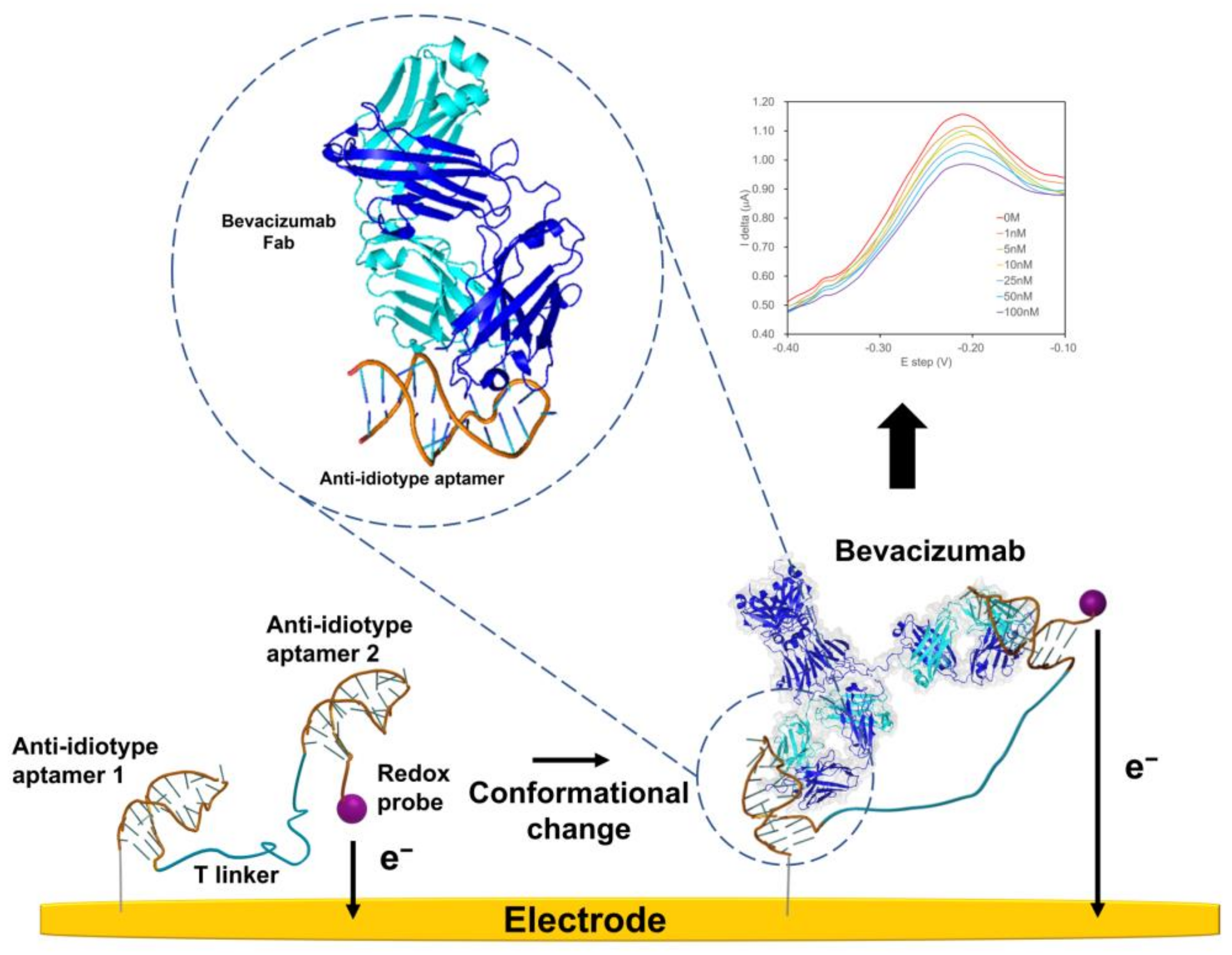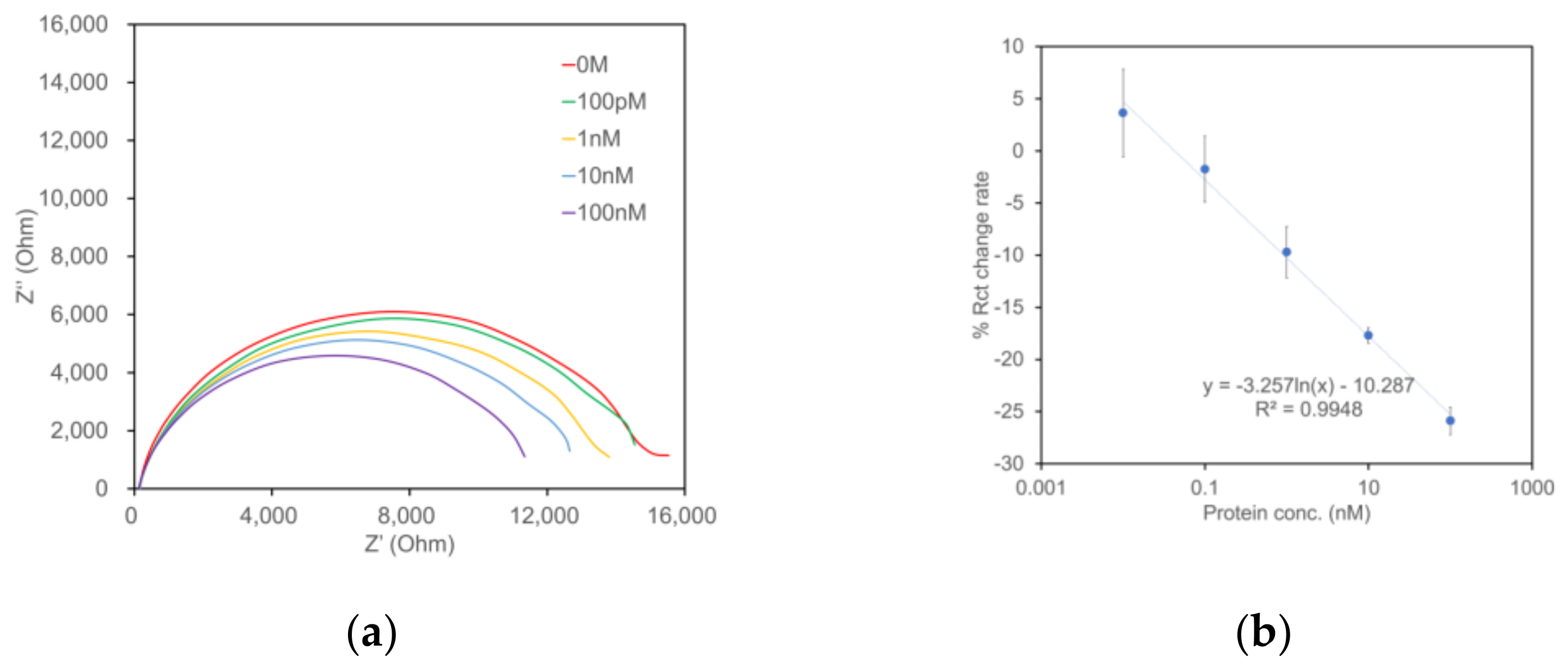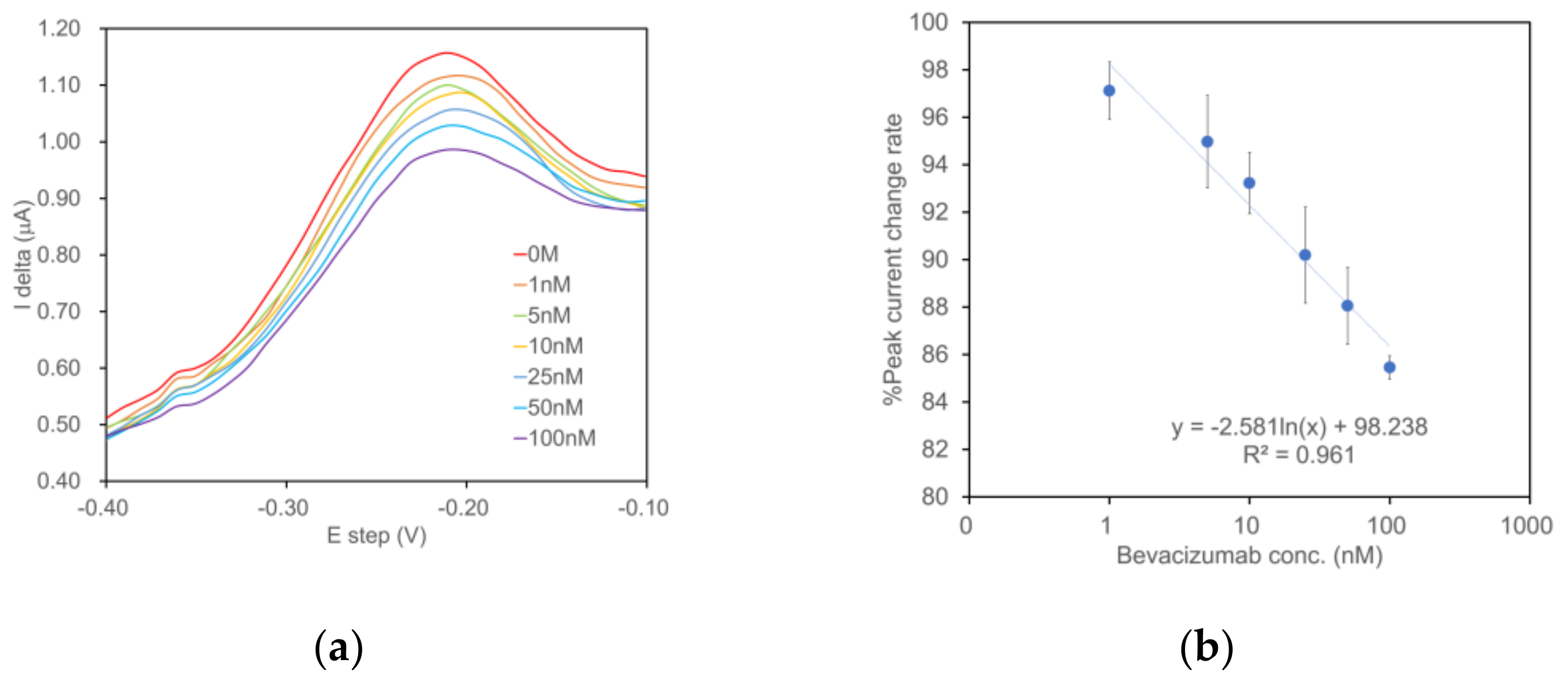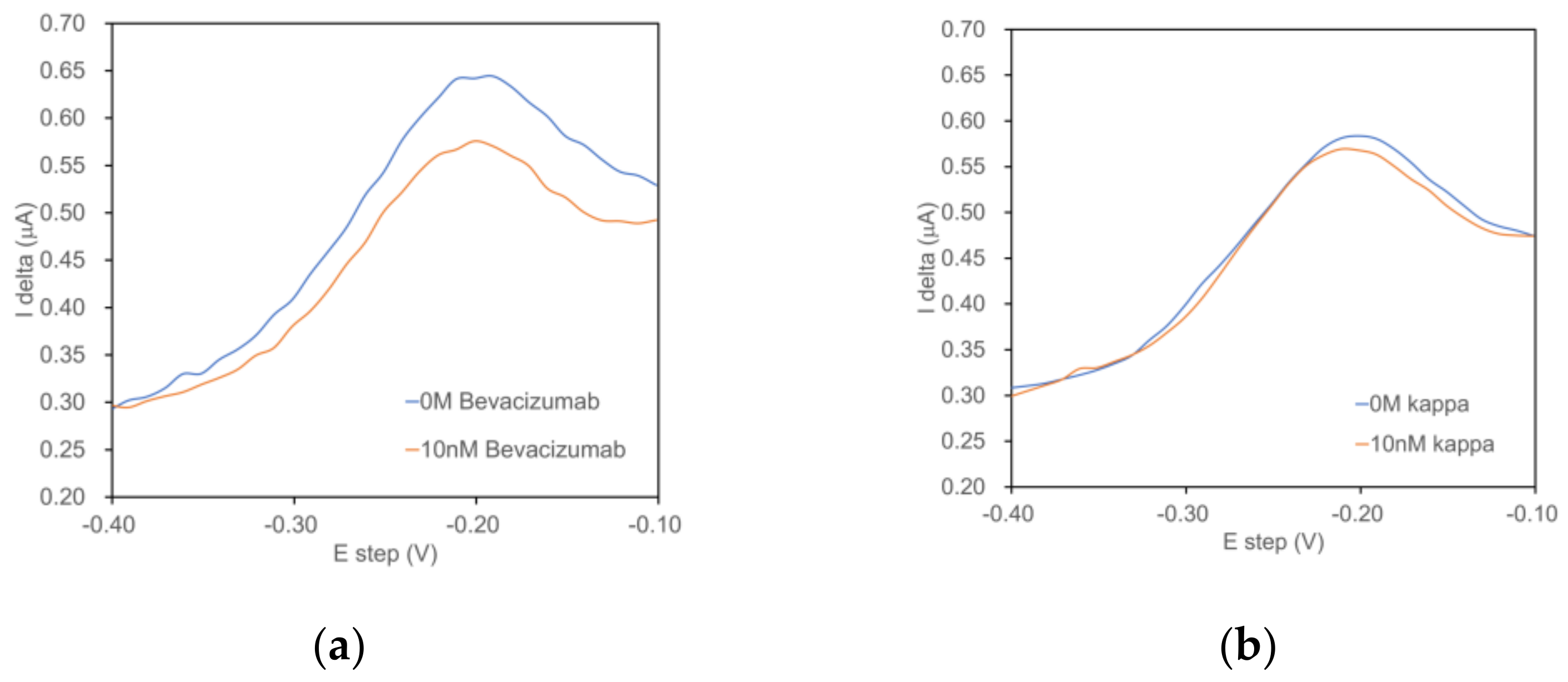Development of an Anti-Idiotype Aptamer-Based Electrochemical Sensor for a Humanized Therapeutic Antibody Monitoring
Abstract
1. Introduction
2. Results
2.1. Electrochemical Characterization of Anti-Bevacizumab Aptamer Immobilized Electrode
2.2. Characterization of Bevacizumab Sensor Employing Redox Probe Modified Anti-Bevacizumab Aptamers
2.3. Bevacizumab Detection from Artificial Serum Solution
3. Discussion
4. Materials and Methods
4.1. Chemical and Materials
4.2. Preparation and Operation of Faradaic EIS-Based Bevacizumab Sensor
4.3. Preparation and Operational Conditions of SWV-Based Bevacizumab Sensor Using PES-Modified Aptamer
5. Conclusions
Supplementary Materials
Author Contributions
Funding
Institutional Review Board Statement
Informed Consent Statement
Data Availability Statement
Acknowledgments
Conflicts of Interest
References
- Smith, A.J. New Horizons in Therapeutic Antibody Discovery: Opportunities and Challenges versus Small-Molecule Therapeutics. J. Biomol. Screen. 2015, 20, 437–453. [Google Scholar] [CrossRef]
- Nugue, G.; Bidart, M.; Arlotto, M.; Mousseau, M.; Berger, F.; Pelletier, L. Monitoring Monoclonal Antibody Delivery in Oncology: The Example of Bevacizumab. PLoS ONE 2013, 8, e72021. [Google Scholar] [CrossRef]
- Cong, Y.; Zhang, Z.; Zhang, S.; Hu, L.; Gu, J. Quantitative MS Analysis of Therapeutic MAbs and Their Glycosylation for Pharmacokinetics Study. Proteom.-Clin. Appl. 2016, 10, 303–314. [Google Scholar] [CrossRef]
- Van den Broek, I.; Niessen, W.M.; van Dongen, W.D. Bioanalytical LC–MS/MS of Protein-Based Biopharmaceuticals. J. Chromatogr. B 2013, 929, 161–179. [Google Scholar] [CrossRef]
- Todoroki, K.; Yamada, T.; Mizuno, H.; TOYO’OKA, T. Current Mass Spectrometric Tools for the Bioanalyses of Therapeutic Monoclonal Antibodies and Antibody-Drug Conjugates. Anal. Sci. 2018, 34, 397–406. [Google Scholar] [CrossRef]
- Ternant, D.; Cézé, N.; Lecomte, T.; Degenne, D.; Duveau, A.-C.; Watier, H.; Dorval, E.; Paintaud, G. An Enzyme-Linked Immunosorbent Assay to Study Bevacizumab Pharmacokinetics. Ther. Drug Monit. 2010, 32, 647–652. [Google Scholar] [CrossRef]
- Yu, D.-A.; You, M.; Ji, W.-W.; Lu, Y.; Liu, B.; Yan, S.-S. Preclinical Pharmacokinetics of a Recombinant Humanized Rabbit Anti-VEGF Monoclonal Antibody in Rabbits and Monkeys. Toxicol. Lett. 2018, 292, 73–77. [Google Scholar] [CrossRef]
- Martínez-Ortega, A.; Herrera, A.; Salmerón-García, A.; Cabeza, J.; Cuadros-Rodríguez, L.; Navas, N. Study and ICH Validation of a Reverse-Phase Liquid Chromatographic Method for the Quantification of the Intact Monoclonal Antibody Cetuximab. J. Pharm. Anal. 2016, 6, 117–124. [Google Scholar] [CrossRef]
- Van Rosmalen, M.; Ni, Y.; Vervoort, D.F.; Arts, R.; Ludwig, S.K.; Merkx, M. Dual-Color Bioluminescent Sensor Proteins for Therapeutic Drug Monitoring of Antitumor Antibodies. Anal. Chem. 2018, 90, 3592–3599. [Google Scholar] [CrossRef]
- Zeni, L.; Perri, C.; Cennamo, N.; Arcadio, F.; D’Agostino, G.; Salmona, M.; Beeg, M.; Gobbi, M. A Portable Optical-Fibre-Based Surface Plasmon Resonance Biosensor for the Detection of Therapeutic Antibodies in Human Serum. Sci. Rep. 2020, 10, 1–9. [Google Scholar] [CrossRef]
- Tuerk, C.; Gold, L. Systematic Evolution of Ligands by Exponential Enrichment: RNA Ligands to Bacteriophage T4 DNA Polymerase. Science 1990, 249, 505–510. [Google Scholar] [CrossRef] [PubMed]
- Ellington, A.D.; Szostak, J.W. In Vitro Selection of RNA Molecules That Bind Specific Ligands. Nature 1990, 346, 818–822. [Google Scholar] [CrossRef]
- Sefah, K.; Phillips, J.A.; Xiong, X.; Meng, L.; Van Simaeys, D.; Chen, H.; Martin, J.; Tan, W. Nucleic Acid Aptamers for Biosensors and Bio-Analytical Applications. Analyst 2009, 134, 1765–1775. [Google Scholar] [CrossRef]
- Toh, S.Y.; Citartan, M.; Gopinath, S.C.; Tang, T.-H. Aptamers as a Replacement for Antibodies in Enzyme-Linked Immunosorbent Assay. Biosens. Bioelectron. 2015, 64, 392–403. [Google Scholar] [CrossRef]
- Xiao, Y.; Lubin, A.A.; Heeger, A.J.; Plaxco, K.W. Label-Free Electronic Detection of Thrombin in Blood Serum by Using an Aptamer-Based Sensor. Angew. Chem. 2005, 117, 5592–5595. [Google Scholar] [CrossRef]
- Lao, Y.-H.; Chiang, H.-Y.; Yang, D.-K.; Peck, K.; Chen, L.-C. Selection of Aptamers Targeting the Sialic Acid Receptor of Hemagglutinin by Epitope-Specific SELEX. Chem. Commun. 2014, 50, 8719–8722. [Google Scholar] [CrossRef]
- Zumrut, H.E.; Ara, M.N.; Fraile, M.; Maio, G.; Mallikaratchy, P. Ligand-Guided Selection of Target-Specific Aptamers: A Screening Technology for Identifying Specific Aptamers against Cell-Surface Proteins. Nucleic Acid Ther. 2016, 26, 190–198. [Google Scholar] [CrossRef]
- Hamm, J.; Huber, J.; Lührmann, R. Anti-Idiotype RNA Selected with an Anti-Nuclear Export Signal Antibody Is Actively Transported in Oocytes and Inhibits Rev-and Cap-Dependent RNA Export. Proc. Natl. Acad. Sci. USA 1997, 94, 12839–12844. [Google Scholar] [CrossRef]
- Saito, T.; Shimizu, Y.; Tsukakoshi, K.; Abe, K.; Lee, J.; Ueno, K.; Asano, R.; Jones, B.V.; Yamada, T.; Nakano, T. Development of a DNA Aptamer That Binds to the Complementarity-Determining Region of Therapeutic Monoclonal Antibody and Affinity Improvement Induced by PH-Change for Sensitive Detection. Biosens. Bioelectron. 2022, 203, 114027. [Google Scholar] [CrossRef]
- Weiner, L.M.; Surana, R.W.S. Monoclonal Antibodies: Versatile Platforms for Cancer Immunotherapy. Nat. Rev. Immunol. 2010, 10, 317–327. [Google Scholar] [CrossRef]
- Sliwkowski, M.X.; Mellman, I. Antibody Therapeutics in Cancer. Science 2013, 341, 1192–1198. [Google Scholar] [CrossRef]
- Yamada, T.; Saito, T.; Hill, Y.; Shimizu, Y.; Tsukakoshi, K.; Mizuno, H.; Hayashi, H.; Ikebukuro, K.; Toyo’oka, T.; Todoroki, K. High-Throughput Bioanalysis of Bevacizumab in Human Plasma Based on Enzyme-Linked Aptamer Assay Using Anti-Idiotype DNA Aptamer. Anal. Chem. 2019, 91, 3125–3130. [Google Scholar] [CrossRef]
- Yamada, T.; Saito, T.; Shimizu, Y.; Tsukakoshi, K.; Hayashi, H.; Mizuno, H.; Tsuji, D.; Yamamoto, K.; Itoh, K.; Toyo’oka, T. Anti-Idiotype DNA Aptamer Affinity Purification–High-Temperature Reversed-Phase Liquid Chromatography: A Simple, Accurate, and Selective Bioanalysis of Bevacizumab. Molecules 2019, 24, 857. [Google Scholar] [CrossRef] [PubMed]
- Hwang, B.; Lee, S.-W. Improvement of RNA Aptamer Activity against Myasthenic Autoantibodies by Extended Sequence Selection. Biochem. Biophys. Res. Commun. 2002, 290, 656–662. [Google Scholar] [CrossRef]
- Wang, Y.-K.; Zou, Q.; Sun, J.-H.; Wang, H.; Sun, X.; Chen, Z.-F.; Yan, Y.-X. Screening of Single-Stranded DNA (SsDNA) Aptamers against a Zearalenone Monoclonal Antibody and Development of a SsDNA-Based Enzyme-Linked Oligonucleotide Assay for Determination of Zearalenone in Corn. J. Agric. Food Chem. 2015, 63, 136–141. [Google Scholar] [CrossRef]
- Todoroki, K.; Nakano, T.; Eda, Y.; Ohyama, K.; Hayashi, H.; Tsuji, D.; Min, J.Z.; Inoue, K.; Iwamoto, N.; Kawakami, A. Bioanalysis of Bevacizumab and Infliximab by High-Temperature Reversed-Phase Liquid Chromatography with Fluorescence Detection after Immunoaffinity Magnetic Purification. Anal. Chim. Acta 2016, 916, 112–119. [Google Scholar] [CrossRef]
- Mikačić, I.; Belužić, R.; Vugrek, O.; Plavljanić, D. A Proximity Extension Assay (PEA)-Based Method for Quantification of Bevacizumab. J. Pharmacol. Toxicol. Methods 2018, 92, 20–23. [Google Scholar] [CrossRef]
- Gaspar, V.P.; Ibrahim, S.; Sobsey, C.A.; Richard, V.R.; Spatz, A.; Zahedi, R.P.; Borchers, C.H. Direct and Precise Measurement of Bevacizumab Levels in Human Plasma Based on Controlled Methionine Oxidation and Multiple Reaction Monitoring. ACS Pharmacol. Transl. Sci. 2020, 3, 1304–1309. [Google Scholar] [CrossRef]
- Xiao, Y.; Lai, R.Y.; Plaxco, K.W. Preparation of Electrode-Immobilized, Redox-Modified Oligonucleotides for Electrochemical DNA and Aptamer-Based Sensing. Nat. Protoc. 2007, 2, 2875–2880. [Google Scholar] [CrossRef]
- Nagata, M.; Lee, J.; Henley, S.; Ikebukuro, K.; Sode, K. An Amine-Reactive Phenazine Ethosulfate (ArPES)—A Novel Redox Probe for Electrochemical Aptamer-Based Sensor. Sensors 2022, 22, 1760. [Google Scholar] [CrossRef]





| Measurement Principle | Probe | Time | Range | LOD | Ref |
|---|---|---|---|---|---|
| enzyme-linked immunosorbent assay (ELISA) | VEGF | 6 h | 34–500 nM | 0.22 nM | [6] |
| Immunoassay with a suspension array | VEGF | 2 h | 34–500 nM | - | [2] |
| HT-RPLC with antibody | Antibody | >2 h | 6.7–133 nM | 0.46 nM | [26] |
| Proximity extension assay | Antibody | 1–1000 pM | 1 pM (LLOQ) | [27] | |
| Enzyme-linked aptamer assay (ELAA) | Aptamer | >4 h | 340 pM–34 nM | 14 pM | [22] |
| HT-RPLC with aptamer | Aptamer | >2 h | 6.7–340 nM | 1 nM | [23] |
| Liquid chromatography-based multiple reaction monitoring MS | - | >6 h | 12 nM | [28] | |
| Electrochemical detection with free redox probe | Aptamer | >160 min | 31-500 pM | 0.1 nM | [19] |
| Voltammetry | Aptamer | 30 min | 1–100 nM 1–100 nM | 9.1 nM (PBS) 10.1 nM (artificial-serum) | This study |
Disclaimer/Publisher’s Note: The statements, opinions and data contained in all publications are solely those of the individual author(s) and contributor(s) and not of MDPI and/or the editor(s). MDPI and/or the editor(s) disclaim responsibility for any injury to people or property resulting from any ideas, methods, instructions or products referred to in the content. |
© 2023 by the authors. Licensee MDPI, Basel, Switzerland. This article is an open access article distributed under the terms and conditions of the Creative Commons Attribution (CC BY) license (https://creativecommons.org/licenses/by/4.0/).
Share and Cite
Nagata, M.; Lee, J.; Saito, T.; Ikebukuro, K.; Sode, K. Development of an Anti-Idiotype Aptamer-Based Electrochemical Sensor for a Humanized Therapeutic Antibody Monitoring. Int. J. Mol. Sci. 2023, 24, 5277. https://doi.org/10.3390/ijms24065277
Nagata M, Lee J, Saito T, Ikebukuro K, Sode K. Development of an Anti-Idiotype Aptamer-Based Electrochemical Sensor for a Humanized Therapeutic Antibody Monitoring. International Journal of Molecular Sciences. 2023; 24(6):5277. https://doi.org/10.3390/ijms24065277
Chicago/Turabian StyleNagata, Madoka, Jinhee Lee, Taro Saito, Kazunori Ikebukuro, and Koji Sode. 2023. "Development of an Anti-Idiotype Aptamer-Based Electrochemical Sensor for a Humanized Therapeutic Antibody Monitoring" International Journal of Molecular Sciences 24, no. 6: 5277. https://doi.org/10.3390/ijms24065277
APA StyleNagata, M., Lee, J., Saito, T., Ikebukuro, K., & Sode, K. (2023). Development of an Anti-Idiotype Aptamer-Based Electrochemical Sensor for a Humanized Therapeutic Antibody Monitoring. International Journal of Molecular Sciences, 24(6), 5277. https://doi.org/10.3390/ijms24065277







